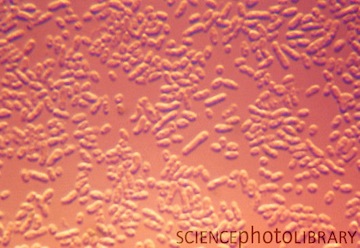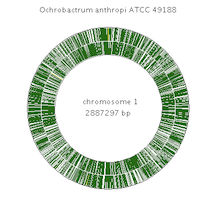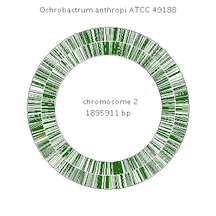Ochrobactrum anthropi: Difference between revisions
| (131 intermediate revisions by 2 users not shown) | |||
| Line 1: | Line 1: | ||
{{Uncurated}} | {{Uncurated}} | ||
{{Biorealm Genus}} | {{Biorealm Genus}} | ||
==Classification== | ==Classification== | ||
[[Image:Ochrobactrum_anthropi.jpg|frame|right|10px|Photo By Michael Abbey/Science Photo Library]] | |||
===Higher order taxa=== | ===Higher order taxa=== | ||
Bacteria; Proteobacteria; Alphaproteobacteria; Rhizobiales; Brucellaceae; | Bacteria (Domain); Proteobacteria (Phylum); Alphaproteobacteria (Class); Rhizobiales (Order); Brucellaceae (Family); ''Ochrobacterium'' (Genus); ''Ochrobacterium anthropi'' (Species) | ||
===Species=== | ===Species=== | ||
NCBI: Taxonomy, Genome | ''Ochrobacterium anthropi'' | ||
NCBI: [http://www.ncbi.nlm.nih.gov/Taxonomy/Browser/wwwtax.cgi?id=529 Taxonomy], [http://www.ncbi.nlm.nih.gov/genome/732 Genome] | |||
==Description and significance== | ==Description and significance== | ||
O. anthropi is a common soil alphaproteobacteria that colonizes a wide spectrum of organisms and is being increasingly recognized as a potentially problematic opportunistic and nosocomial human pathogen.1 Though it is extremely rare for it to | ''O. anthropi'', formerly known as ''Achromobacter species'' (CDC group Vd), is a common soil [http://en.wikipedia.org/wiki/Alphaproteobacteria alphaproteobacteria] that colonizes a wide spectrum of organisms and is being increasingly recognized as a potentially problematic [http://en.wikipedia.org/wiki/Opportunistic_infection opportunistic] and [http://en.wikipedia.org/wiki/Nosocomial nosocomial] human pathogen.[1] Though it is extremely rare for it to affect a healthy human, there have been numerous published cases being associated with the presence of indwelling medical devices, such as central venous catheters, drainage tubes, and intraperitoneal catheters. It is also characterized by a broad spectrum of [http://en.wikipedia.org/wiki/Antibiotic_resistance antibiotic resistance].[2] | ||
==Genome structure== | ==Genome structure== | ||
[[Image:Chromosome1.png|frame|left|100px|O. anthropi Chromosome 1 [7]]] [[Image: OantC2.png|frame|left|100px|O. anthropi Chromosome 2 [8]]] | |||
The 4.8-Mb [http://en.wikipedia.org/wiki/Genome genome] of ''O. anthropi'' consists of two non-identical [http://en.wikipedia.org/wiki/Circular_bacterial_chromosome circular chromosomes]. The genome has an average C+G content of 56.22% and together comprise 4,424 protein-coding genes (~87% coding), along with 31 [http://en.wikipedia.org/wiki/Pseudogenes pseudogenes] and 73 structural RNA's (rRna, tRNA, and small RNA). | |||
The ''O. anthropi'' genome also contains four [http://en.wikipedia.org/wiki/Plasmids plasmids]. [http://gtps.ddbj.nig.ac.jp/single/index.php?chid=Oant_ATCC49188%3ApOANT01 pOAN01], [http://gtps.ddbj.nig.ac.jp/single/index.php?chid=Oant_ATCC49188%3ApOANT02 pOAN02], and [http://gtps.ddbj.nig.ac.jp/single/index.php?chid=Oant_ATCC49188%3ApOANT03 pOAN03] have the expected characteristics of alphaproteobacterial plasmids, but [http://gtps.ddbj.nig.ac.jp/single/index.php?chid=Oant_ATCC49188%3ApOANT04 pOAN04] doesn't - it lacks known replication, partition, and conjugative systems.[1] | |||
[[Image:Soil.jpg|frame|right|100px|O.anthropi environment [9]]] | |||
==Structure and Ecology== | |||
''O. anthropi'' is a versatile alphaproteobacterium with ability to colonize an exceptionally wide variety of habitats, from hostile environments such as polluted soil, to water, plants, nematodes, insects, animals, and humans. [5] They are rod shaped, [http://en.wikipedia.org/wiki/Gram-negative gram negative], and motile by means of [http://en.wikipedia.org/wiki/Flagellum peritrichous flagella].[6] After growth on nutrient agar, the colonies are about 1 μm in diameter, non-pigmented, circular, low convex, smooth, shining, and entire. The optimum temperature for growth is between 20 and 37˚C.[6] | |||
== | ==Metabolism== | ||
''O. anthropi'' organisms are [http://en.wikipedia.org/wiki/Obligate_aerobic obligately aerobic], possessing a strictly respiratory type of metabolism with O<sub>2</sub> as the terminal electron acceptor. They are chemoorganotrophic, using various amino acids, organic acids, and carbohydrates as carbon sources and are both oxidase and catalase positive. They also reduce both nitrate and nitrite by [http://en.wikipedia.org/wiki/Assimilation_%28biology%29 assimilation].[3][6] | |||
O. anthropi | |||
==Pathology== | ==Pathology== | ||
Although cases of O. anthropi being pathogenic are rare, there are | |||
[[Image:Endocarditis.jpg|frame|left|100px|Bacterial Endocarditis [10]]] | |||
Although cases of ''O. anthropi'' being [http://en.wikipedia.org/wiki/Pathogenic_bacteria pathogenic] are rare, there are several documented cases showing that it is possible for individuals with an underlying medical condition. Among these individuals, those with an indwelling medical device, such as catheters and drainage tubes, are most susceptible. This is likely due to its ability to adhere to various synthetic materials.[3] The effects of ''O. anthropi'' when pathogenic seem to vary greatly in severity depending on the host. It causes [http://en.wikipedia.org/wiki/Bacteremia bacteremia] which can cause [http://en.wikipedia.org/wiki/Sepsis sepsis], [http://en.wikipedia.org/wiki/Septic_shock septic shock] and can even lead to life-threatening infections - such as [http://en.wikipedia.org/wiki/Infective_endocarditis infective endocarditis] and [http://en.wikipedia.org/wiki/Osteomyelitis osteomyelitis].[4] ''O. anthropi'' has a very broad spectrum of antibiotic resistance (particularly to β-lactams) which makes it is difficult to treat.[2] | |||
==References== | ==References== | ||
1. Patrick S. G. Chain, Dorothy M. Lang, Diego J. Comerci, Stephanie A. Malfatti, Lisa M. Vergez, Maria Shin, Rodolfo A. Ugalde, Emilio Garcia, Marcello E. Tolmasky. Genome of Ochrobactrum anthropi ATCC 49288T a Versatile Opportunistic Pathogen and Symbiont od Several Eukaryotic Hosts. Journal of Bacteriology 2011. | [http://jb.asm.org/content/193/16/4274.full 1.] Patrick S. G. Chain, Dorothy M. Lang, Diego J. Comerci, Stephanie A. Malfatti, Lisa M. Vergez, Maria Shin, Rodolfo A. Ugalde, Emilio Garcia, Marcello E. Tolmasky. Genome of <I>Ochrobactrum anthropi</I> ATCC 49288T a Versatile Opportunistic Pathogen and Symbiont od Several Eukaryotic Hosts. Journal of Bacteriology 2011. doi: 10.1128/JB.05335-11 | ||
[http://jcm.asm.org/content/41/3/1339.full?maxtoshow=&hits=10&RESULTFORMAT=&fulltext=pfge&searchid=1&FIRSTINDEX=1270&resourcetype=HWFIG 2.] Adrian Kettaneh, Francois-Xavior Weill, Isabelle Poilane, Oliver Fran, Michel Thomas, Jean-Louis Herrmann, Laurent Hocqueloux. Septic Shock Caused by <I>Ochrobactrum anthropi</I> in an Otherwise Healthy Host. J. Clin Microbiol 2003. doi: 10.1128/JCM.41.3.1339-1341.2003 | |||
[http://cid.oxfordjournals.org/content/18/6/914.abstract?ijkey=70d9e3c48f6a550af8747aba3ca055ac55560b5f&keytype2=tf_ipsecsha 3.] Alnor D, Frimodt-Moller N, Espersen F, Frederiksen W. Infections with the Unusual Human Pathogens Agrobacterium Species and <I>Ochrobactrum anthropi</I>. Clinical Infectious Diseases 1994. doi: 10.1093/clinids/18.6.914 | |||
[http://www.ncbi.nlm.nih.gov/pubmed/10908026 4.] Mahmood MS, Sarwari AR, Khan MA, Sophie Z, Khan E, Sami S. Infective Endocarditis and Septic Embolization with <I>Ochrobactrum anthropi</I>: case report and review of literature. The Journal of Infection 2000. doi: 10.1053/jinf.2000.0644 | |||
[http://www.ncbi.nlm.nih.gov/pmc/articles/PMC2810298/ 5.] Sara Romano, Fabian Aujoulat, Estelle Jumas-Bilak, Anges Masnou, Jean-Luc Jeannot, Envold Falsen, Helene Marchandin, Corinne Teyssier. Multilocus Sequence Typing Supports the Hypothesis that <I>Ochrobactrum anthropi</I> Displays a Human-Associated Subpopulation. BMC Microbiology 2009. doi: 10.1186/1471-2180-9-267 | |||
[http://ijs.sgmjournals.org/content/38/4/406.full.pdf 6.] B. Holmes, M. Popoff, M. Kiredjian, M. Kersters. Ochrobactrum anthropi gen. nov., sp. nov. from Human Clinical Specimens and Previously Known as Group Vd. International Journal of Systematic and Evolutionary Microbiology 2012. doi: 10.1099/00207713-38-4-406 | |||
[http://gtps.ddbj.nig.ac.jp/single/index.php?spid=Oant_ATCC49188 7.] Genome View Ochrobactrum anthropi ATCC 49188 chromosome 1. Gene Trek in Prokaryote Space (GTPS). DNA Data Bank of Japan. | |||
[http://gtps.ddbj.nig.ac.jp/single/index.php?chid=Oant_ATCC49188%3A02 8.] Genome View Ochrobactrum anthropi ATCC 49188 chromosome 2. Gene Trek in Prokaryote Space (GTPS). DNA Data Bank of Japan. | |||
[http://www.foodcrumbs.com/2011/03/31/garden-soil/ 9.] Soil. Food crumbs blog. | |||
[http://www.scai.org/SecondsCount/Resources/Detail.aspx?cid=06f57640-4f1e-4403-a7b9-cd812f78c2cd 10] Endocarditis. The Society for Cardiovascular Angiography and Interventions. | |||
Edited by Eric Beaver of Dr. Lisa R. Moore, University of Southern Maine, Department of Biological Sciences, http://www.usm.maine.edu/bio | Edited by Eric Beaver of Dr. Lisa R. Moore, University of Southern Maine, Department of Biological Sciences, http://www.usm.maine.edu/bio | ||
Latest revision as of 18:34, 6 May 2012
A Microbial Biorealm page on the genus Ochrobactrum anthropi
Classification
Higher order taxa
Bacteria (Domain); Proteobacteria (Phylum); Alphaproteobacteria (Class); Rhizobiales (Order); Brucellaceae (Family); Ochrobacterium (Genus); Ochrobacterium anthropi (Species)
Species
Ochrobacterium anthropi
Description and significance
O. anthropi, formerly known as Achromobacter species (CDC group Vd), is a common soil alphaproteobacteria that colonizes a wide spectrum of organisms and is being increasingly recognized as a potentially problematic opportunistic and nosocomial human pathogen.[1] Though it is extremely rare for it to affect a healthy human, there have been numerous published cases being associated with the presence of indwelling medical devices, such as central venous catheters, drainage tubes, and intraperitoneal catheters. It is also characterized by a broad spectrum of antibiotic resistance.[2]
Genome structure
The 4.8-Mb genome of O. anthropi consists of two non-identical circular chromosomes. The genome has an average C+G content of 56.22% and together comprise 4,424 protein-coding genes (~87% coding), along with 31 pseudogenes and 73 structural RNA's (rRna, tRNA, and small RNA). The O. anthropi genome also contains four plasmids. pOAN01, pOAN02, and pOAN03 have the expected characteristics of alphaproteobacterial plasmids, but pOAN04 doesn't - it lacks known replication, partition, and conjugative systems.[1]
Structure and Ecology
O. anthropi is a versatile alphaproteobacterium with ability to colonize an exceptionally wide variety of habitats, from hostile environments such as polluted soil, to water, plants, nematodes, insects, animals, and humans. [5] They are rod shaped, gram negative, and motile by means of peritrichous flagella.[6] After growth on nutrient agar, the colonies are about 1 μm in diameter, non-pigmented, circular, low convex, smooth, shining, and entire. The optimum temperature for growth is between 20 and 37˚C.[6]
Metabolism
O. anthropi organisms are obligately aerobic, possessing a strictly respiratory type of metabolism with O2 as the terminal electron acceptor. They are chemoorganotrophic, using various amino acids, organic acids, and carbohydrates as carbon sources and are both oxidase and catalase positive. They also reduce both nitrate and nitrite by assimilation.[3][6]
Pathology
Although cases of O. anthropi being pathogenic are rare, there are several documented cases showing that it is possible for individuals with an underlying medical condition. Among these individuals, those with an indwelling medical device, such as catheters and drainage tubes, are most susceptible. This is likely due to its ability to adhere to various synthetic materials.[3] The effects of O. anthropi when pathogenic seem to vary greatly in severity depending on the host. It causes bacteremia which can cause sepsis, septic shock and can even lead to life-threatening infections - such as infective endocarditis and osteomyelitis.[4] O. anthropi has a very broad spectrum of antibiotic resistance (particularly to β-lactams) which makes it is difficult to treat.[2]
References
1. Patrick S. G. Chain, Dorothy M. Lang, Diego J. Comerci, Stephanie A. Malfatti, Lisa M. Vergez, Maria Shin, Rodolfo A. Ugalde, Emilio Garcia, Marcello E. Tolmasky. Genome of Ochrobactrum anthropi ATCC 49288T a Versatile Opportunistic Pathogen and Symbiont od Several Eukaryotic Hosts. Journal of Bacteriology 2011. doi: 10.1128/JB.05335-11
2. Adrian Kettaneh, Francois-Xavior Weill, Isabelle Poilane, Oliver Fran, Michel Thomas, Jean-Louis Herrmann, Laurent Hocqueloux. Septic Shock Caused by Ochrobactrum anthropi in an Otherwise Healthy Host. J. Clin Microbiol 2003. doi: 10.1128/JCM.41.3.1339-1341.2003
3. Alnor D, Frimodt-Moller N, Espersen F, Frederiksen W. Infections with the Unusual Human Pathogens Agrobacterium Species and Ochrobactrum anthropi. Clinical Infectious Diseases 1994. doi: 10.1093/clinids/18.6.914
4. Mahmood MS, Sarwari AR, Khan MA, Sophie Z, Khan E, Sami S. Infective Endocarditis and Septic Embolization with Ochrobactrum anthropi: case report and review of literature. The Journal of Infection 2000. doi: 10.1053/jinf.2000.0644
5. Sara Romano, Fabian Aujoulat, Estelle Jumas-Bilak, Anges Masnou, Jean-Luc Jeannot, Envold Falsen, Helene Marchandin, Corinne Teyssier. Multilocus Sequence Typing Supports the Hypothesis that Ochrobactrum anthropi Displays a Human-Associated Subpopulation. BMC Microbiology 2009. doi: 10.1186/1471-2180-9-267
6. B. Holmes, M. Popoff, M. Kiredjian, M. Kersters. Ochrobactrum anthropi gen. nov., sp. nov. from Human Clinical Specimens and Previously Known as Group Vd. International Journal of Systematic and Evolutionary Microbiology 2012. doi: 10.1099/00207713-38-4-406
7. Genome View Ochrobactrum anthropi ATCC 49188 chromosome 1. Gene Trek in Prokaryote Space (GTPS). DNA Data Bank of Japan.
8. Genome View Ochrobactrum anthropi ATCC 49188 chromosome 2. Gene Trek in Prokaryote Space (GTPS). DNA Data Bank of Japan.
9. Soil. Food crumbs blog.
10 Endocarditis. The Society for Cardiovascular Angiography and Interventions.
Edited by Eric Beaver of Dr. Lisa R. Moore, University of Southern Maine, Department of Biological Sciences, http://www.usm.maine.edu/bio





